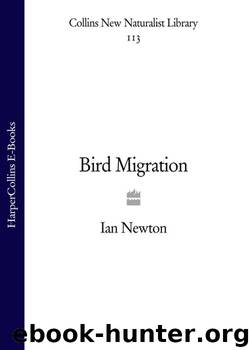Bird Migration by Ian Newton

Author:Ian Newton [Newton, Ian]
Language: eng
Format: epub
ISBN: 978-0-00-737972-9
Publisher: HarperCollins Publishers
Published: 2010-07-09T16:00:00+00:00
Greater fecundity is one way in which a migratory population could gain a competitive advantage over resident occupants in a shared wintering area where resources are limited. Even if the two populations competed on equal terms on their shared wintering range, with no difference in average survival rates, the population with the higher average breeding rate would in time increase at the expense of the other, either holding it at a much lower level or eliminating it altogether in their shared range. In many bird species, clutch sizes and nest survival rates increase with latitude (in association with the greater seasonal surge in food supplies and longer days found at high latitudes in summer), so we would often expect the higher-latitude populations of a species to be the most fecund.
This consideration may help to explain why many migratory birds do not breed in their wintering areas even though conditions seem suitable there year-round. For example, the Osprey does not breed in the tropics and subtropics of Africa and South America, even though the bulk of the northern continental populations winter there, and the immatures from these populations remain there year-round. Ospreys can obviously survive through the year at low latitudes, and the most likely reason they do not nest there is that they can achieve higher individual reproductive output by migrating to breed at higher latitudes, returning for the intervening winters. According to this view, residency does not evolve in tropical–subtropical regions, because competition from winter immigrants would eliminate a resident sector in any population limited by winter food or other resources.
Intra-specific competition on the wintering grounds could thus have a major influence on the overall population sizes, distributions and migrations of birds (Bell, 2000). Through the process of post-glacial range expansion, and the associated development of migration, we have a possible explanation for two of the most familiar patterns of winter distribution found among migratory birds—the chain and leapfrog systems—as well as for the wide separation of breeding and wintering areas shown by some species. Another pattern, called ‘telescopic’ migration, occurs when the whole breeding population from a wide span of latitude concentrates for the winter in the southern part of the range (Chapter 18). This situation may occur where competition, or habitat availability, is insufficient to promote the development of the chain or leapfrog patterns, or it may represent a temporary situation which will eventually lead to chain or leapfrog patterns.
Download
This site does not store any files on its server. We only index and link to content provided by other sites. Please contact the content providers to delete copyright contents if any and email us, we'll remove relevant links or contents immediately.
Sapiens: A Brief History of Humankind by Yuval Noah Harari(13979)
The Tidewater Tales by John Barth(12391)
Mastermind: How to Think Like Sherlock Holmes by Maria Konnikova(6932)
Do No Harm Stories of Life, Death and Brain Surgery by Henry Marsh(6683)
The Thirst by Nesbo Jo(6432)
Why We Sleep: Unlocking the Power of Sleep and Dreams by Matthew Walker(6348)
Life 3.0: Being Human in the Age of Artificial Intelligence by Tegmark Max(5182)
Sapiens by Yuval Noah Harari(5117)
The Longevity Diet by Valter Longo(4856)
The Body: A Guide for Occupants by Bill Bryson(4577)
The Rules Do Not Apply by Ariel Levy(4520)
The Immortal Life of Henrietta Lacks by Rebecca Skloot(4248)
Why We Sleep by Matthew Walker(4190)
Animal Frequency by Melissa Alvarez(4148)
Yoga Anatomy by Kaminoff Leslie(4100)
The Hacking of the American Mind by Robert H. Lustig(4080)
All Creatures Great and Small by James Herriot(3980)
Barron's AP Biology by Goldberg M.S. Deborah T(3941)
Double Down (Diary of a Wimpy Kid Book 11) by Jeff Kinney(3921)
